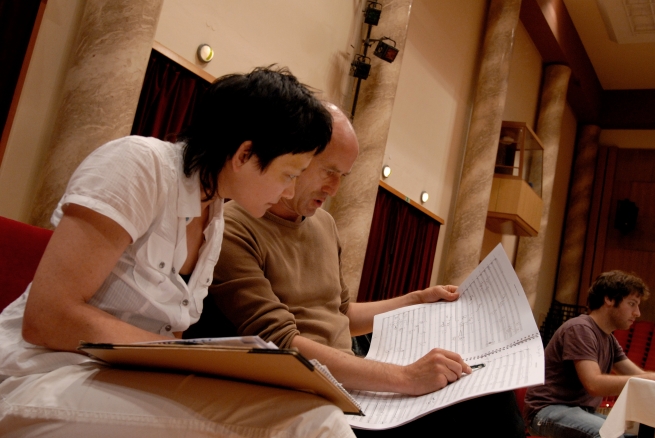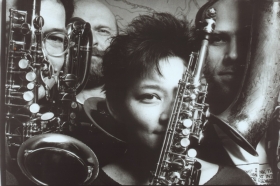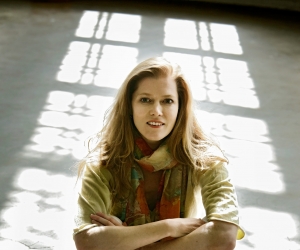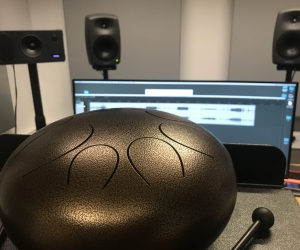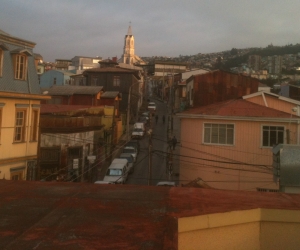“I keep coming back to light on water,” says Chiyoko Szlavnics, explaining her interest in beating, that intriguing fluttering effect that arises when sound waves of slightly differing frequencies coincide. “It’s a very similar kind of synaptic experience—for me, at least. We don’t hear beating in music, normally. But it moves me, like sunlight dancing on water. I’m very drawn to the complexity that is present in nature, mesmerized by it, and my great desire is somehow to reflect something of that complexity in my work.”
Music and drawing have run a parallel and closely related course through the work of this Toronto-born artist, resident in Berlin since 1998. Her compositions have been performed and her graphic art exhibited on both sides of the Atlantic. The drawings began as an integral part of her compositional process, a preliminary mapping of musical ideas, with lines on paper standing for tones extended through time, or representing specific instrumental intervals.
“I don’t consider those early drawings to be conceptual at all,” she now remarks, “even though they represent sound in a kind of abstract way. They are not to be interpreted other than as what they are—just representing sounds, one to one, in my imagined sound world. I have always distanced myself from the tradition of graphic scores. There have been so many of those, and I want to differentiate what I do. So I still don’t release my drawings, even though musicians often approach me for them, wanting to base improvisations on them. I’m happy that people feel inspired, but I consider it my task, as composer, to interpret the drawings musically as specifically as possible, to decide, amid all the possibilities, what notes and chords will be played, to notate and orchestrate that.”
Gradients of Detail, Szlavnics’ debut CD, featuring three of her musical compositions, was issued in the late fall of 2013 by Maria De Alvear’s World Edition imprint. On its cover is an elegant black-and-white drawing from her recent moiré series of images. Fine lines inscribed by a technical pen converge and are superimposed so that they shimmer in the manner of watered silk. “My early drawings came to seem very two-dimensional,” Szlavnics explains. “I soon began to feel that I knew how they would sound, and the music that developed from them did actually start to repeat certain things. So I decided to find a third dimension in the drawings; to do that, I had to release myself from the idea that they would represent sounds one to one.” The new moiré series—although still rooted in ideas and observations of acoustic phenomena that Szlavnics has been working with for a long time—has greater aesthetic autonomy than her earlier drawings. These images have grown from her work in music, yet, as she recognizes, they would have to be greatly simplified to be rendered translatable into sound. “The drawings can take on a life of their own,” she observes. “Something is appearing on the page, and I’m only subconsciously involved in its evolution.”
That intricate image on the cover of Gradients of Detail makes it clear that her creative ground is a place where geometry nurtures imagination and precise lines yield poetry. On adjacent ground, in 1923 William Carlos Williams, inspired by cubist Juan Gris’ 1914 painting The Flower, wrote “The Rose,” a poem charged with astonishment at the capacity of art to revitalize perception and of perception to breathe new life into imagery grown stale through overuse. Here are its closing stanzas.
From the petal’s edge a line starts
that being of steel
infinitely fine, infinitely
rigid penetrates
the Milky Way
without contact—lifting
from it—neither hanging
nor pushing—
The fragility of the flower
unbruised
penetrates space
Szlavnics is today comparably involved with aesthetic configurations and representations of the phenomenal world that do not simply endorse convention and satisfy expectations, but through economical yet rigorous means aspire to renew our encounters with art and with nature.
Sustained vibrato-free tones thread through her composition (a)long lines: we’ll draw our own lines, performed on Gradients of Detail by Cologne-based Ensemble musikFabrik. Sine waves interweave with violin, cello, flute, and trombone, steering the ear towards infinity, like those steely projections in “The Rose.” But they swerve and curve unpredictably, like particles in ancient physics, and out of their crossing and collision comes the efflorescence and fresh detail of her music.
At the University of Toronto, Szlavnics received a traditional musical education, primarily as a flutist and saxophonist. But her identity as a creative artist has been shaped more significantly by influences absorbed before and after that period. Her maternal grandfather, the son of Japanese immigrants, was an avid nature lover, a passionate fisherman and mushroom hunter, who liked to roam the forests on Canada’s west coast. As a child, Szlavnics would occasionally visit him, and they would walk the beaches, which were littered, she remembers vividly, with driftwood, stones, kelp, and small crabs. “He never tired of taking me to the salmon run on the north shore of Vancouver, and explaining the life cycle of the salmon. For me, the creative power necessary to make living art taps into that same source. The birds are gearing up right now in Berlin with the arrival of spring, an organized cacophony of birdsong that can fill one’s head so that urban noise disappears. That’s the regenerative power of nature.”
Fertile interplay of the various arts was also a daily accompaniment to Szlavnics’ experience of childhood. Her mother Aiko Suzuki was an accomplished and multifaceted artist who painted, worked with textiles, made sculptures, and designed dance sets for choreographer Patricia Beatty. “After the Second World War, my mother tried to become as non-Japanese as possible—a sort of beatnik, a wild artist living in Toronto in the ’60s.” Later, it bothered her when people described what they found in her work as having an Asian aesthetic. “Personally, I think that the Japanese background is significant to my desire to make work that has a lot of space in it.” Her father, half-Serbian and half-Hungarian, fled Europe after the Second World War. He too was a talented artist. “He was highly analytical, and I inherited that. One of the reasons I so much enjoy living in Berlin is that people here discuss things so analytically.”
After graduating at the end of the 1980s, Szlavnics joined Hemispheres, a Toronto-based new music and improvising ensemble then under the artistic direction of the late Nic Gotham, who had studied with influential American experimental composer James Tenney. “In 1993, Nic invited me to write a piece for the group, so I composed a chamber quartet for clarinet, trumpet, violin, and percussion,” Szlavnics recalls. “That was when I used drawings for the first time as a way of organizing, in advance, what I wanted to create in the sound itself. But nonetheless, that piece went all over the place; I couldn’t manage—as I had wished—to keep just one idea going through it. So I sought out Jim Tenney, whose music I had performed with Hemispheres.”
Between 1993 and her departure for Germany, Szlavnics had private composition lessons with Tenney and regularly attended seminars at his house. “Jim was very much interested in setting up processes and then hearing the results. He and I talked about controlling different parameters, and about being able to envision the development of a piece ahead of time—to plan it, almost. We also discussed the work of the German acoustic physicist Hermann von Helmholtz. We shared an interest in the physics of sound. Jim introduced me to just intonation, which later became an interest of mine. But his lasting influence, for me, has very much been the spirit of making experiments within his work. I now feel able to create systems based on things I have observed in sound and that I am curious about and want to pursue. Jim enabled me to feel I could follow my muse, and create art out of that.”
On arrival in Berlin, Szlavnics discovered venues such as Haus 19, where radical experimentation was welcome, and she was surprised to find a well-established climate of enthusiasm for the work of Jim Tenney and other American composers, such as Alvin Lucier and LaMonte Young. Their work was often performed in the city. She had landed in a community sympathetic to her own aesthetic leanings. Fellow Canadian expatriate Marc Sabat—also a student of Tenney, and deeply involved with just intonation—became her close friend and artistic ally, and she collaborated extensively with adventurous fellow saxophonist Ulrich Krieger. She also encountered the reductive and exploratory strategies of the echtzeitmusik (real-time music) scene, and performed music of quiet intensity with members of the Wandelweiser collective. Composer Peter Ablinger’s group Ensemble Zwischentöne attracted her in particular because it embraced unorthodox approaches connected with the visual and conceptual; its concerts were, she recalls appreciatively, “an unknown quantity.”
During her early days in Berlin, Szlavnics heard a performance of Christian Wolff’s Percussionist Songs by visiting American Robyn Schulkowsky, a musician “who, with just one stroke on a drum, seemed to connect with the voice of the instrument,” enthuses Szlavnics. She was inspired to write a series of solo percussion pieces, among them the feline and sonorous Her Teeth Were White. On Gradients of Detail it is performed with great finesse by Dirk Rothbrust, another percussionist with that capacity to animate sound rather than simply interpret a score.
Szlavnics invariably writes with specific performers in mind. “It is very important for me not only to imagine the sounds of the instruments, but to know the people involved. That actually increases my desire to write for those particular instruments. Sounds are not then anonymous; human spirits are involved in producing them.” But Szlavnics does not often seek out musicians. Instead, she responds to concert opportunities. At the time of this interview, she is busily engaged in writing a large chamber piece for the next Donaueschingen Festival, held in October 2014. “This week I’m meeting the musicians from Klangforum Wien who will perform it. I know meeting with them, individually, is going to affect profoundly how I write that piece. Setting up dates for an exchange with them is an extremely important part of the compositional process. Meeting musicians and then writing for them means I am not just working with notes on a page. So I’m in a strange phase right now—being very careful. The drawings remain extremely important as a point of departure, but in order to make crucial decisions about orchestration I have to be so close to the notation that I can really imagine what it is going to sound like. The notation is where the music’s detail is happening in this current piece.”
Szlavnics has composed a number of shorter works, including some—such as For Eva Hesse for sine waves, and For Agnes Martin for two violins and accordion—written as expressions of gratitude to artists whose work has particular resonance for her. But it is works of extended duration—often single-movement compositions that stretch across twenty minutes, half an hour, or more—that suit especially well the terms of her involvement with sound. “My shorter works show something, or do something, and then they are over. The long pieces are more about experiencing sound that is different from the kind of music that gratifies our anticipation of certain conventional structures. Extended duration allows sound to become almost like what you might hear in the environment. The slowed-down-ness of these pieces allows you to hear beating and other unexpected acoustic phenomena. A stillness enters the music, allowing listeners to notice things, to think, and to reflect. That’s part of what space in music means for me—that space for listening.”
Two specific experiences back home in Canada underpin her long-term interest in extended musical durations. In 1993, theatre director Floyd Favel invited Szlavnics to create music, as composer and performer on flute and saxophone, for a project with Cree choreographer and dancer Michael Greyeyes. The piece, Child of 10,000 Years, was first presented by New Dance Horizons in Regina, Saskatchewan; a further version—for which Szlavnics extended the music to include cello—was performed at the Canada Dance Festival in 1994. During this project Szlavnics got to hear trains blowing their horns in the far distance, out on the prairies. “The length of those sounds, and their quality due to the distance they had travelled before reaching the room where I was staying, had a great impact on me. That vast, open landscape—where so much sky is visible at a glance that one can see not just local cloud movement but entire weather systems—gave me the feeling that I was hearing the sound in its completeness, in space as well as in time.” How those horns combined—with a slight bend in frequency, their glissando and blast at the beginning, their long decrescendo and echo at the end—had a deep influence on her next composition, a saxophone quartet.
“Writing that piece some months later, I had another revelatory experience, standing outside and hearing the winter wind move slowly through a grove of oak trees, through their dry, dead leaves, still on the branches. I could hear the wind’s movement in space, at first in these leaves, then in those on another tree.” That subtle sound of natural motion, altering in colour as the wind changed speed, fed into Papyrus Bending, which she then performed in the 40 Fingers saxophone quartet, with fellow players Gotham, David Mott, and Peter Lutek. It was her first reduced piece, with elongated figures and intervals that change in surprising ways.
“I want to be surprised by my music. This is my main goal, to be blown away by what comes out.”
Szlavnics cites the example of her recent orchestral composition
Reservoir (symphonic), which was given its premiere in Stuttgart in November 2013. “That really bowled me over. It took at least two months before I could listen to it and not feel strange. I was trying to transfer something of my smaller-setting works into an orchestral medium. You can’t do much to change the sound of an orchestra; for much of the time it sounds simply like itself. But I took risks in the scoring, like having most of the musicians sitting there doing nothing a lot of the time, in order to keep the music’s textures very thin.” Her experience at the premiere performances of the three works on
Gradients of Detail was comparably overwhelming, although during the recording process, she acknowledges, the music inevitably becomes known and familiar. “The process becomes about perfecting pieces as they are now, trying to convey the contents of the music, rather than being surprised by it.”
Szlavnics used to write a lot of poetry, and feels that what she does today is indeed poetic, in that it involves responses to people and to natural settings combined, and also that it arises so intensely from her personal experience of the living world. “As a legacy of my university training, I still open books of theory and try to understand what it is about, that theoretical knowledge, which academics want to establish so firmly. Why should I reject it, or why am I still grappling with it? There’s a strange tension between having some knowledge based on conservative canons and rejecting it, for whatever reason. We have certain science that explains things for us theoretically, but it doesn’t really help us with our personal experience of those things. When one experiments, and makes discoveries oneself, the phenomenal world feels so much more alive than if you are limited to an academic theory. There’s something so inspiring about that direct experience. What I’m always striving for in my work is that something, that spark which you can’t see beforehand, but which is quite magical when it occurs.”
*
CORRECTION (#119, Summer 2014): The drawing on pg. 40 of the print issue was indentified incorrectly in the caption on pg. 41. The same drawing appears at the top of this article post, with the correct description provided below. Musicworks regrets the error.
Audio: Constellations I (composed by Chiyoko Szlavnics for Eve Egoyan. Performed by Eve Egoyan.) Homepage image of Chiyoko Szlavnics by: Philipp Hennig. Image (top): Moiré Series, ink on paper by Chiyoko Szlavnic (2012), is featured on the cover of Szlavnic’s CD Gradients of Detail (World Edition). Image (middle): Chiyoko Szlavnics (left) with Peter Rundel, conductor of Ostravská Banda at the 2007 Ostrava Days Festival. Image by: Martin Polelář. Image (bottom): Toronto saxophone quartet 40 Fingers, circa the late 1990s.

